
Georgetown University is a private Jesuit research university in the Georgetown neighborhood of Washington, D.C., United States. Founded by Bishop John Carroll in 1789, it is the oldest Catholic institution of higher education in the United States, the oldest university in Washington, D.C., and the nation's first federally chartered university.

Patrick Francis Healy was an American Catholic priest and Jesuit who was an influential president of Georgetown University, becoming known as its "second founder". The university's flagship building, Healy Hall, bears his name. Though he considered himself and was widely accepted as White, Healy was posthumously recognized as the first Black American to earn a PhD, as well as the first to enter the Jesuit order and to become the president of a predominantly White university.

The Joseph Mark Lauinger Library is the main library of Georgetown University and the center of the seven-library Georgetown library system that includes 3.5 million volumes. It holds 1.7 million volumes on six floors and has accommodations for individual and group study on all levels. It is generally referred to colloquially as "Lau" by Georgetown students.

Timothy Stafford Healy was an American Catholic priest and Jesuit who straddled the religious and secular life, serving as the vice chancellor of the City University of New York, the president of Georgetown University, and the president of the New York Public Library.
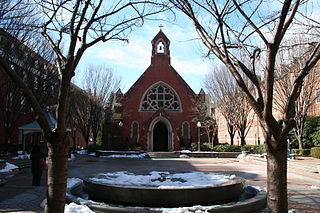
The history of Georgetown University spans nearly 400 years, from the early European settlement of America to the present day. Georgetown University has grown with both its city, Washington, D.C., and the United States, each of which date their founding to the period from 1788 to 1790. Georgetown's origins are in the establishment of the Maryland colony in the seventeenth century. Bishop John Carroll established the school at its present location by the Potomac River after the American Revolution allowed for free religious practice.

The Philodemic Society is a student debating society at Georgetown University founded in 1830 by Father James Ryder, S.J. The Philodemic is among the oldest such societies in the United States, and is the oldest secular student organization at Georgetown. The society's motto, "Eloquentiam Libertati Devinctam" reminds its members that they are pursuing Eloquence in Defense of Liberty.

The Campuses of Georgetown University, the Hilltop Campus, the Capitol Campus, and the Medical Campus, are located within Washington, DC. Georgetown's Hilltop and Medical Campuses are located in Georgetown, Washington, D.C. between Canal Road, Prospect Street, and Reservoir Road. The Capitol Campus is located in downtown DC on New Jersey Avenue, near Union Station. Other parts of Georgetown are located in the D.C. Area, including the Center for Continuing and Professional Education at Clarendon in Arlington, Virginia. Georgetown also has an overseas campus in Education City, Qatar, a facility in Jakarta, Indonesia, and villas in Alanya, Turkey and Fiesole, Italy.

Housing at Georgetown University consists of 14 residence halls at the main campus and a law center campus. Housing on Georgetown's main campus is divided between "halls," usually more traditional dormitories, and "villages", usually less traditional apartment complexes. In addition, Georgetown operates many townhouses in the Georgetown neighborhood, usually for second, third, and fourth-year students.

Bishop John Carroll is a statue by the sculptor Jerome Connor commemorating Archbishop John Carroll, the founder of Georgetown University and the first Catholic bishop in the United States. Located in front of Healy Hall, on university's campus in the Georgetown neighborhood of Washington, D.C., the statue consists of a bronze sculpture of Carroll on top of a granite pedestal.

Paul Johannes Pelz was a German-American architect, best known as the main architect of the Library of Congress in Washington D.C.

Gerard John Campbell was an American Catholic priest, Jesuit, and historian who became the president of Georgetown University. Born in Pennsylvania, he entered the Society of Jesus at the age of 20 and studied at West Baden College and Fordham University, before earning his doctorate at Princeton University. A promising historian, he then taught at Loyola University Maryland, before becoming the executive vice president of Georgetown University in 1963, where he effectively worked as acting president.
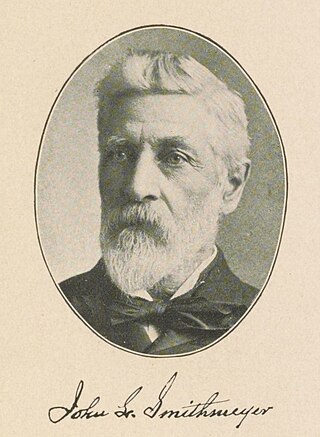
John L. Smithmeyer (1832–1908) was an American architect.

Dahlgren Chapel of the Sacred Heart, often shortened to Dahlgren Chapel, is a Roman Catholic chapel located in Dahlgren Quadrangle on the main campus of Georgetown University in Washington, D.C. The chapel was built in 1893, and is located in the historic center of the campus.

Gaston Hall is an auditorium located on the third and fourth floors of the north tower of Healy Hall on Georgetown University's main campus in Washington, D.C. Named for Georgetown's first student, William Gaston, who also helped secure the university's federal charter, Gaston Hall was completed in 1901, around twenty years after the construction of the building within which it is housed.
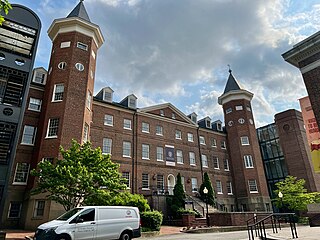
The Old North Building, or simply Old North, is the oldest extant academic building on the campus of Georgetown University in Washington, D.C., and was the second major building built on the campus. To the east, the building is joined to Healy Hall and to the west, it is joined to New North, while the southern façade of the building encloses Dahlgren Chapel. Built in the Georgian style, Old North was one of the grandest buildings in Washington at the time of its completion in 1795. It served as the flagship of the university until the construction of Healy Hall. Old North currently houses the McCourt School of Public Policy.
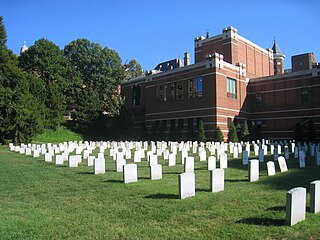
The Jesuit Community Cemetery on the campus of Georgetown University in Washington, D.C., is the final resting place for Jesuits who were affiliated with the university. It was first established in 1808 and was moved to its present location in 1854.
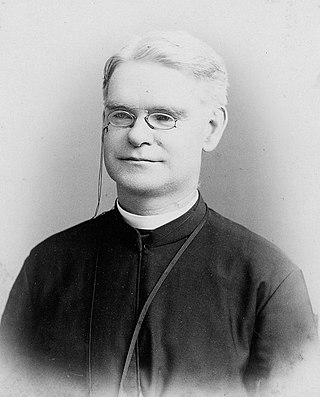
James Aloysius Doonan was an American Catholic priest and Jesuit, who was the president of Georgetown University from 1882 to 1888. During that time he oversaw the naming of Gaston Hall and the construction of a new building for the School of Medicine. Doonan also acquired two historic cannons that were placed in front of Healy Hall. His presidency was financially successful, with a reduction in the university's burdensome debt that had accrued during the construction of Healy Hall.

Joseph Havens Richards was an American Catholic priest and Jesuit who became a prominent president of Georgetown University, where he instituted major reforms and significantly enhanced the quality and stature of the university. Richards was born to a prominent Ohio family; his father was an Episcopal priest who controversially converted to Catholicism and had the infant Richards secretly baptized as a Catholic.
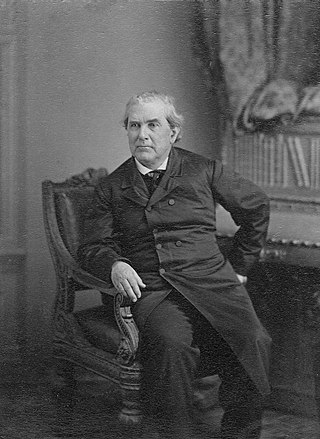
Charles Henry Stonestreet was an American Catholic priest and Jesuit who served in prominent religious and academic positions, including as provincial superior of the Jesuit Maryland Province and president of Georgetown University. He was born in Maryland and attended Georgetown University, where he co-founded the Philodemic Society. After entering the Society of Jesus and becoming a professor at Georgetown, he led St. John's Literary Institution and St. John the Evangelist Church in Frederick, Maryland. He was appointed president of Georgetown University in 1851, holding the office for two years, during which time he oversaw expansion of the university's library. The First Plenary Council of Baltimore was held at Georgetown during his tenure.
































